Abstract
Sixteen thousand resting electrocardiograms were performed on 14000 United Kingdom professional aircrew and air traffic control officers over a two-year period; 103 asymptomatic men with minor ST segment and T wave changes at rest were assessed by exercise electrocardiography and 19 responded abnormally. Five subjects had proven coronary artery disease, one hypertrophic obstructive cardiomyopathy, and one left ventricular dilatation on echocardiography. Eleven subjects were not investigated, of whom three had strongly positive exercise responses. One subject had a false positive response and assuming a false negative response of less than 2 per cent, then a sensitivity of 80.0 per cent, a specificity of 89.1 per cent, a predictive value for the exercise electrocardiogram of 44.46 per cent and for the resting electrocardiogram of 7.8 per cent is obtained. T wave changes induced by hyperventilation were common (53.4% of all). Ten (18.2%) subjects with hyperventilation-induced T wave changes responded abnormally to exercise, three having angiographically proven coronary artery disease lending little support to the contention that the two entities rarely coexist. In spite of the low return from routine electrocardiograms in a population with a low prevalence of coronary artery disease, three-eighths of those with significant coronary artery disease presented with minor ST segment and T wave changes on their resting electrocardiograms.
Full text
PDF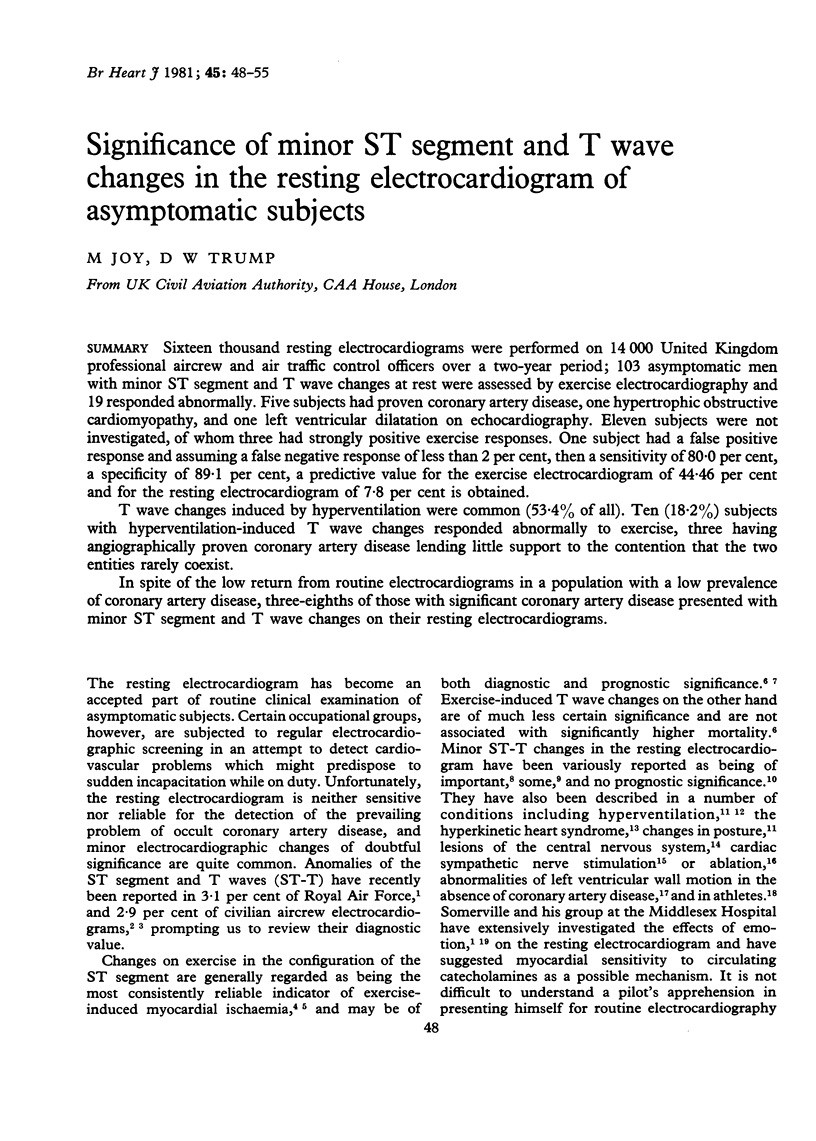
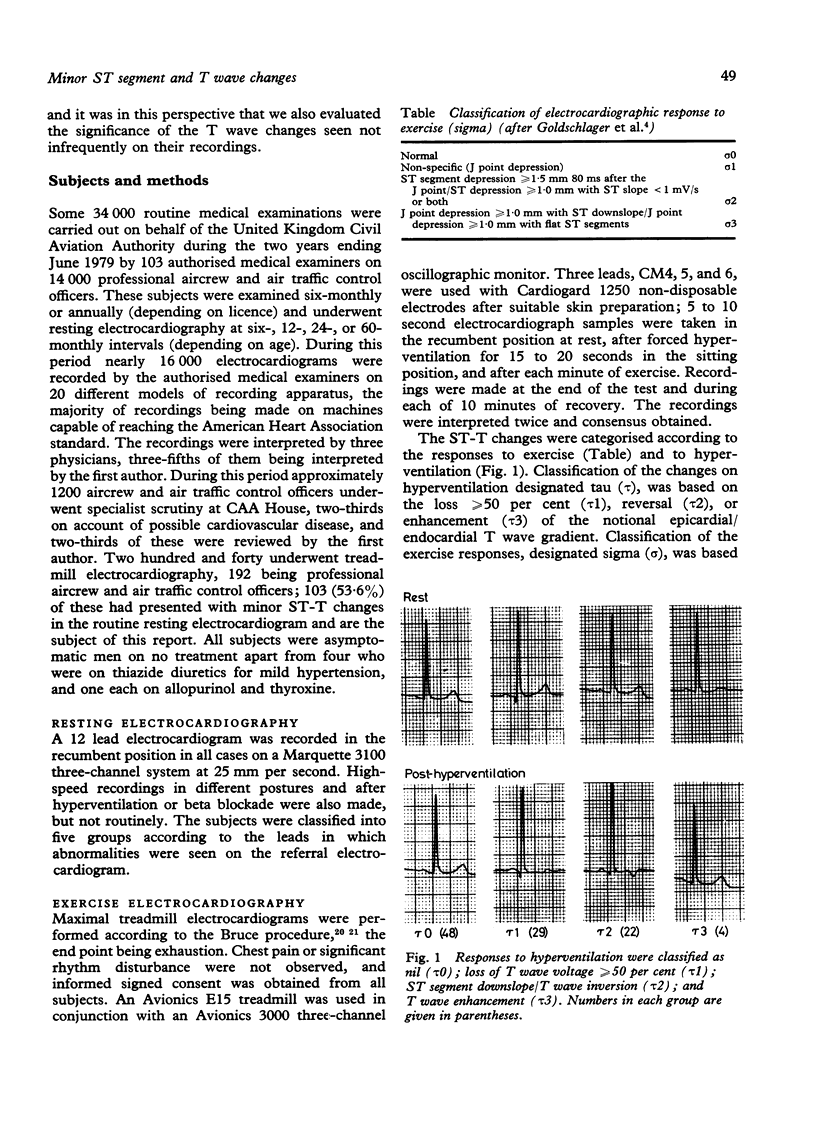


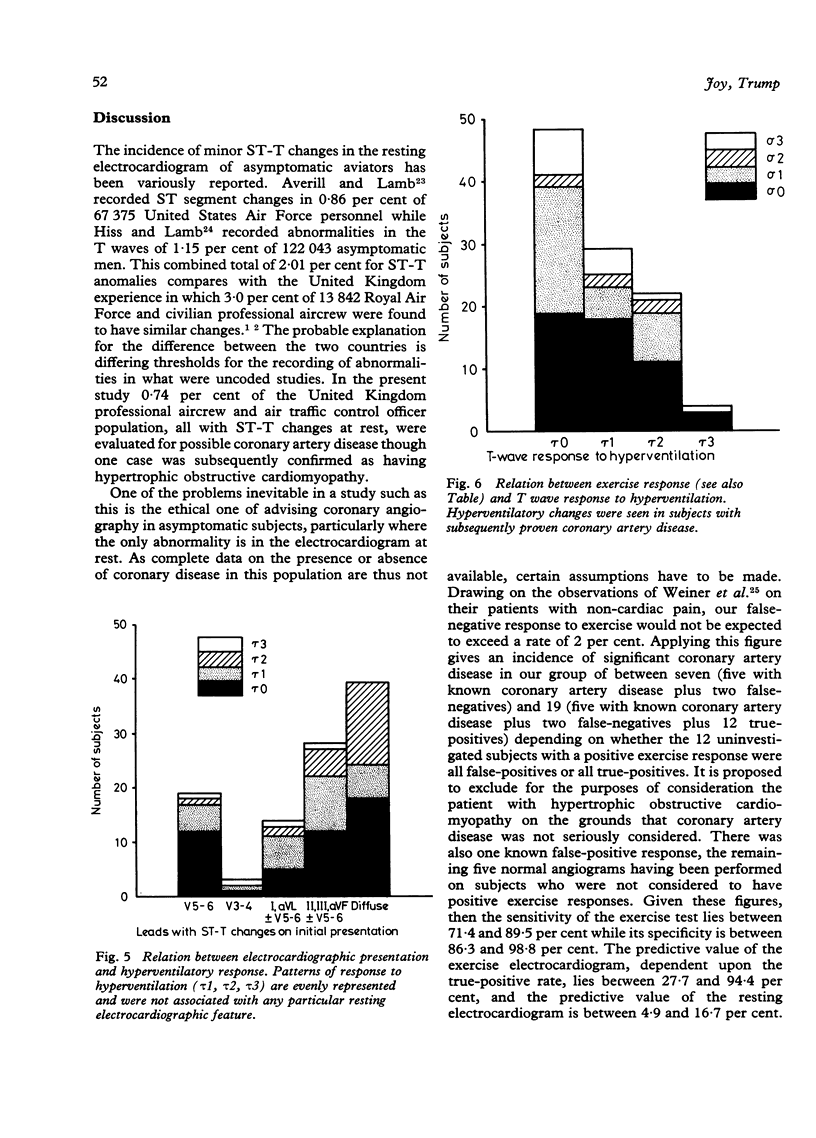
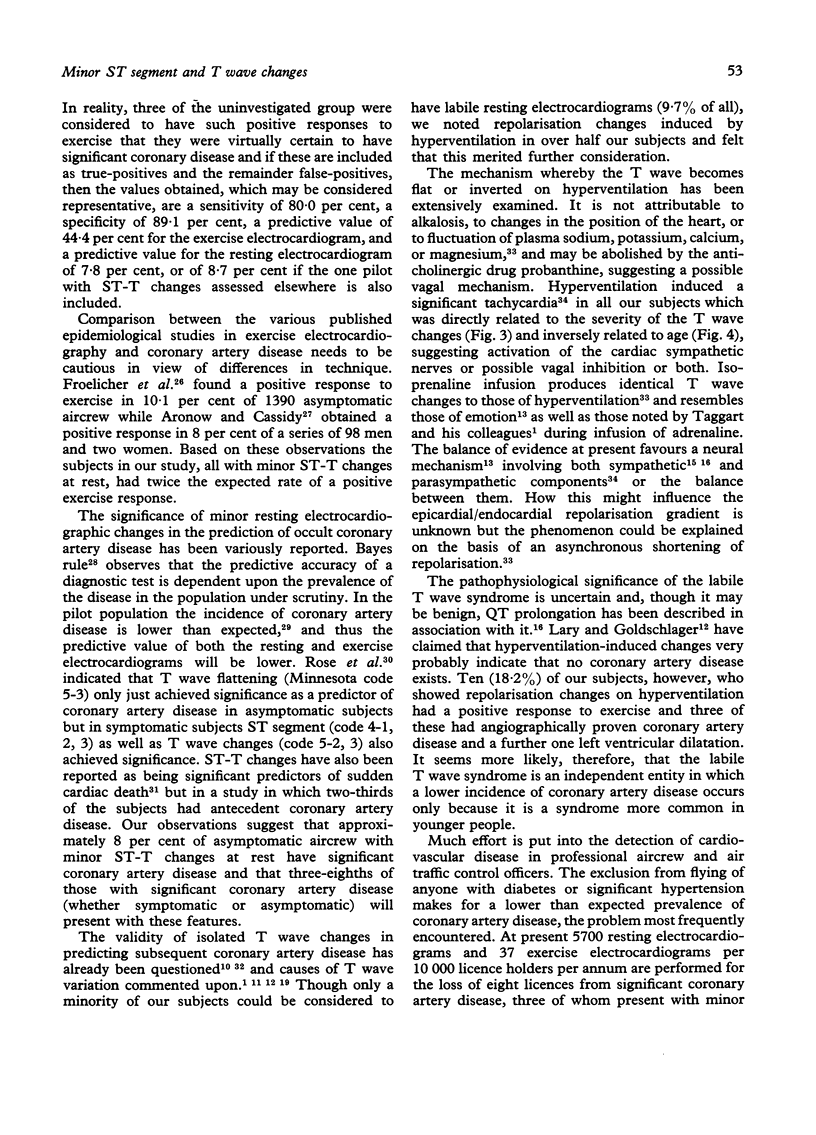
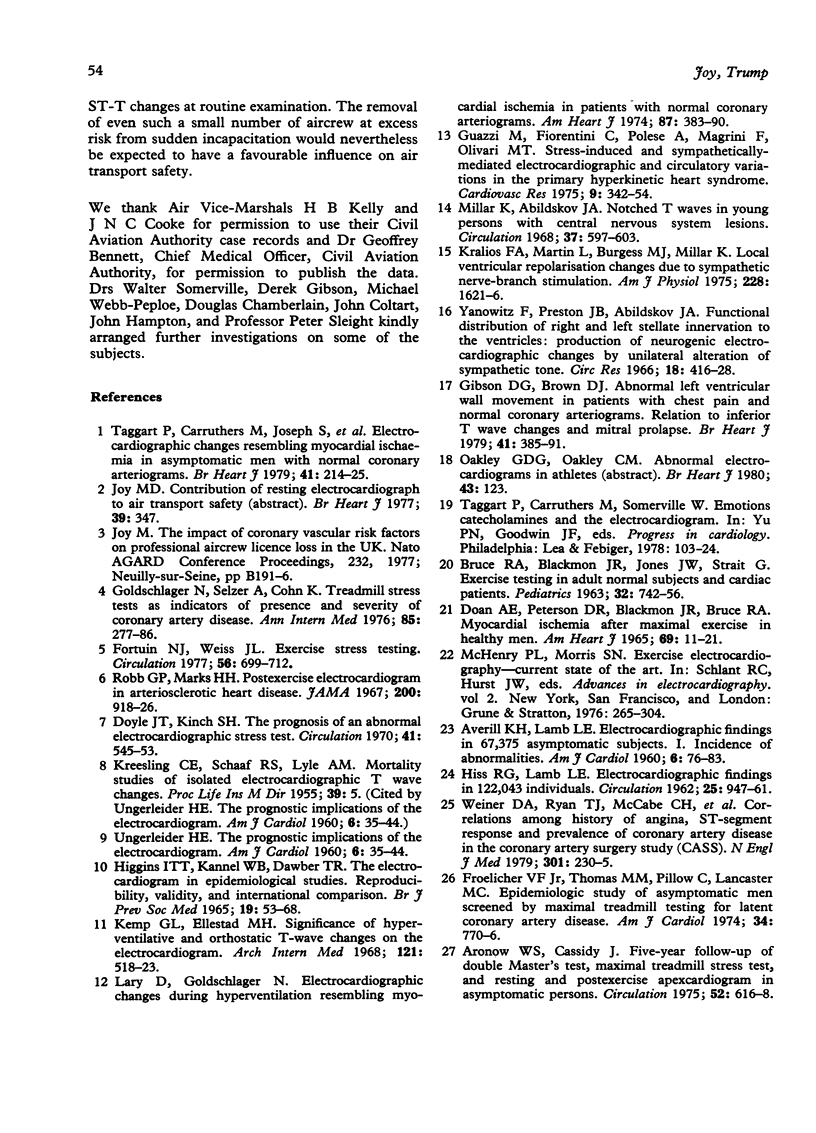
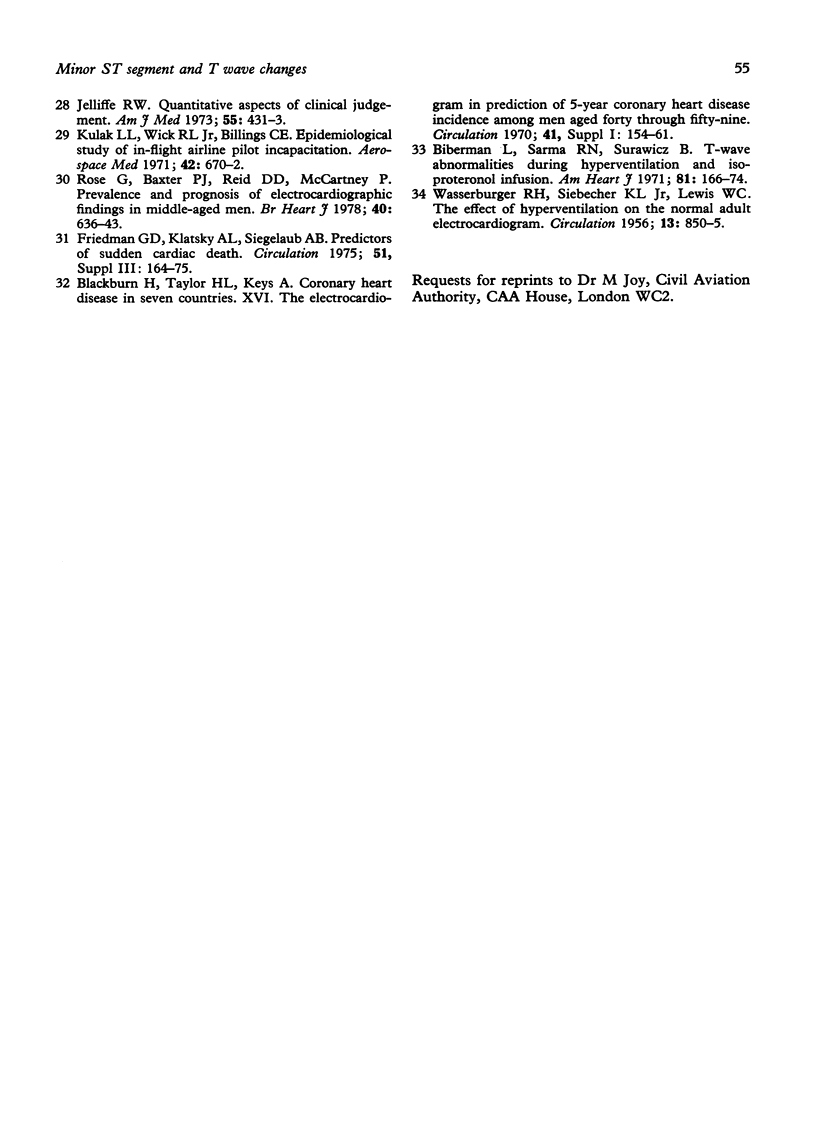
Selected References
These references are in PubMed. This may not be the complete list of references from this article.
- AVERILL K. H., LAMB L. E. Electrocardiographic findings in 67,375 asymptomatic subjects. I. Incidence of abnormalities. Am J Cardiol. 1960 Jul;6:76–83. doi: 10.1016/0002-9149(60)90038-2. [DOI] [PubMed] [Google Scholar]
- Aronow W. S., Cassidy J. Five year follow-up of double Master's test, maximal treadmill stress test, and resting and postexercise apexcardiogram in asymptomatic persons. Circulation. 1975 Oct;52(4):616–618. doi: 10.1161/01.cir.52.4.616. [DOI] [PubMed] [Google Scholar]
- BRUCE R. A., BLACKMON J. R., JONES J. W., STRAIT G. EXERCISING TESTING IN ADULT NORMAL SUBJECTS AND CARDIAC PATIENTS. Pediatrics. 1963 Oct;32:SUPPL–756. [PubMed] [Google Scholar]
- Biberman L., Sarma R. N., Surawicz B. T-wave abnormalities during hyperventilation and isoproterenol infusion. Am Heart J. 1971 Feb;81(2):166–174. doi: 10.1016/0002-8703(71)90127-x. [DOI] [PubMed] [Google Scholar]
- DOAN A. E., PETERSON D. R., BLACKMON J. R., BRUCE R. A. MYOCARDIAL ISCHEMIA AFTER MAXIMAL EXERCISE IN HEALTHY MEN. A METHOD FOR DETECTING POTENTIAL CORONARY HEART DISEASE? Am Heart J. 1965 Jan;69:11–21. doi: 10.1016/0002-8703(65)90211-5. [DOI] [PubMed] [Google Scholar]
- Doyle J. T., Kinch S. H. The prognosis of an abnormal electrocardiographic stress test. Circulation. 1970 Mar;41(3):545–553. doi: 10.1161/01.cir.41.3.545. [DOI] [PubMed] [Google Scholar]
- Fortuin N. J., Weiss J. L. Exercise stress testing. Circulation. 1977 Nov;56(5):699–712. doi: 10.1161/01.cir.56.5.699. [DOI] [PubMed] [Google Scholar]
- Froelicher V. F., Jr, Thomas M. M., Pillow C., Lancaster M. C. Epidemiologic study of asymptomatic men screened by maximal treadmill testing for latent coronary artery disease. Am J Cardiol. 1974 Dec;34(7):770–776. doi: 10.1016/0002-9149(74)90694-8. [DOI] [PubMed] [Google Scholar]
- Gibson D. G., Brown D. J. Abnormal left ventricular wall movement in patients with chest pain and normal coronary arteriograms. Relation to inferior T wave changes and mitral prolapse. Br Heart J. 1979 Apr;41(4):385–391. doi: 10.1136/hrt.41.4.385. [DOI] [PMC free article] [PubMed] [Google Scholar]
- Goldschlager N., Selzer A., Cohn K. Treadmill stress tests as indicators of presence and severity of coronary artery disease. Ann Intern Med. 1976 Sep;85(3):277–286. doi: 10.7326/0003-4819-85-3-277. [DOI] [PubMed] [Google Scholar]
- Guazzi M., Fiorentini C., Polese A., Magrini F., Olivari M. T. Stress-induced and sympathetically-mediated electrocardiographic and circulatory variations in the primary hyperkinetic heart syndrome. Cardiovasc Res. 1975 May;9(3):342–354. doi: 10.1093/cvr/9.3.342. [DOI] [PubMed] [Google Scholar]
- HIGGINS I. T., KANNEL W. B., DAWBER T. R. THE ELECTROCARDIOGRAM IN EPIDEMIOLOGICAL STUDIES: REPRODUCIBILITY, VALIDITY, AND INTERNATIONAL COMPARISON. Br J Prev Soc Med. 1965 Apr;19:53–68. doi: 10.1136/jech.19.2.53. [DOI] [PMC free article] [PubMed] [Google Scholar]
- HISS R. G., LAMB L. E. Electrocardiographic findings in 122,043 individuals. Circulation. 1962 Jun;25:947–961. doi: 10.1161/01.cir.25.6.947. [DOI] [PubMed] [Google Scholar]
- Jelliffe R. W. Editorial: Quantitative aspects of clinical judgment. Am J Med. 1973 Oct;55(3):431–433. doi: 10.1016/0002-9343(73)90199-x. [DOI] [PubMed] [Google Scholar]
- KIESSLING C. E., SCHAAF R. S., LYLE A. M. Mortality studies of isolated electrocardiographic T-wave changes. Trans Assoc Life Insur Med Dir Am. 1956;39:5-19; discussion, 19-24. [PubMed] [Google Scholar]
- Kemp G. L., Ellestad M. H. The significance of hyperventilative and orthostatic T-wave changes on the electrocardiogram. Arch Intern Med. 1968 Jun;121(6):518–523. [PubMed] [Google Scholar]
- Kralios F. A., Martin L., Burgess M. J., Millar K. Local ventricular repolarization changes due to sympathetic nerve-branch stimulation. Am J Physiol. 1975 May;228(5):1621–1626. doi: 10.1152/ajplegacy.1975.228.5.1621. [DOI] [PubMed] [Google Scholar]
- Kulak L. L., Wick R. L., Jr, Billings C. E. Epidemiological study of in-flight airline pilot incapacitation. Aerosp Med. 1971 Jun;42(6):670–672. [PubMed] [Google Scholar]
- LEWIS W. C., SIEBECKER K. L., Jr, WASSERBURGER R. H. The effect of hyperventilation on the normal adult electrocardiogram. Circulation. 1956 Jun;13(6):850–855. doi: 10.1161/01.cir.13.6.850. [DOI] [PubMed] [Google Scholar]
- Lary D., Goldschlager N. Electrocardiographic changes during hyperventilation resembling myocardial ischemia in patients with normal coronary arteriograms. Am Heart J. 1974 Mar;87(3):383–390. doi: 10.1016/0002-8703(74)90081-7. [DOI] [PubMed] [Google Scholar]
- Millar K., Abildskov J. A. Notched T waves in young persons with central nervous system lesions. Circulation. 1968 Apr;37(4):597–603. doi: 10.1161/01.cir.37.4.597. [DOI] [PubMed] [Google Scholar]
- Robb G. P., Marks H. H. Postexercise electrocardiogram in arteriosclerotic heart disease. Its value in diagnosis and prognosis. JAMA. 1967 Jun 12;200(11):918–926. [PubMed] [Google Scholar]
- Rose G., Baxter P. J., Reid D. D., McCartney P. Prevalence and prognosis of electrocardiographic findings in middle-aged men. Br Heart J. 1978 Jun;40(6):636–643. doi: 10.1136/hrt.40.6.636. [DOI] [PMC free article] [PubMed] [Google Scholar]
- Taggart P., Carruthers M., Joseph S., Kelly H. B., Marcomichelakis J., Noble D., O'Neill G., Somerville W. Electrocardiographic changes resembling myocardial ischaemia in asymptomatic men with normal coronary arteriograms. Br Heart J. 1979 Feb;41(2):214–225. doi: 10.1136/hrt.41.2.214. [DOI] [PMC free article] [PubMed] [Google Scholar]
- UNGERLEIDER H. E. The prognostic implications of the electrocardiogram. Am J Cardiol. 1960 Jul;6:35–44. doi: 10.1016/0002-9149(60)90033-3. [DOI] [PubMed] [Google Scholar]
- Weiner D. A., Ryan T. J., McCabe C. H., Kennedy J. W., Schloss M., Tristani F., Chaitman B. R., Fisher L. D. Exercise stress testing. Correlations among history of angina, ST-segment response and prevalence of coronary-artery disease in the Coronary Artery Surgery Study (CASS). N Engl J Med. 1979 Aug 2;301(5):230–235. doi: 10.1056/NEJM197908023010502. [DOI] [PubMed] [Google Scholar]
- Yanowitz F., Preston J. B., Abildskov J. A. Functional distribution of right and left stellate innervation to the ventricles. Production of neurogenic electrocardiographic changes by unilateral alteration of sympathetic tone. Circ Res. 1966 Apr;18(4):416–428. doi: 10.1161/01.res.18.4.416. [DOI] [PubMed] [Google Scholar]


